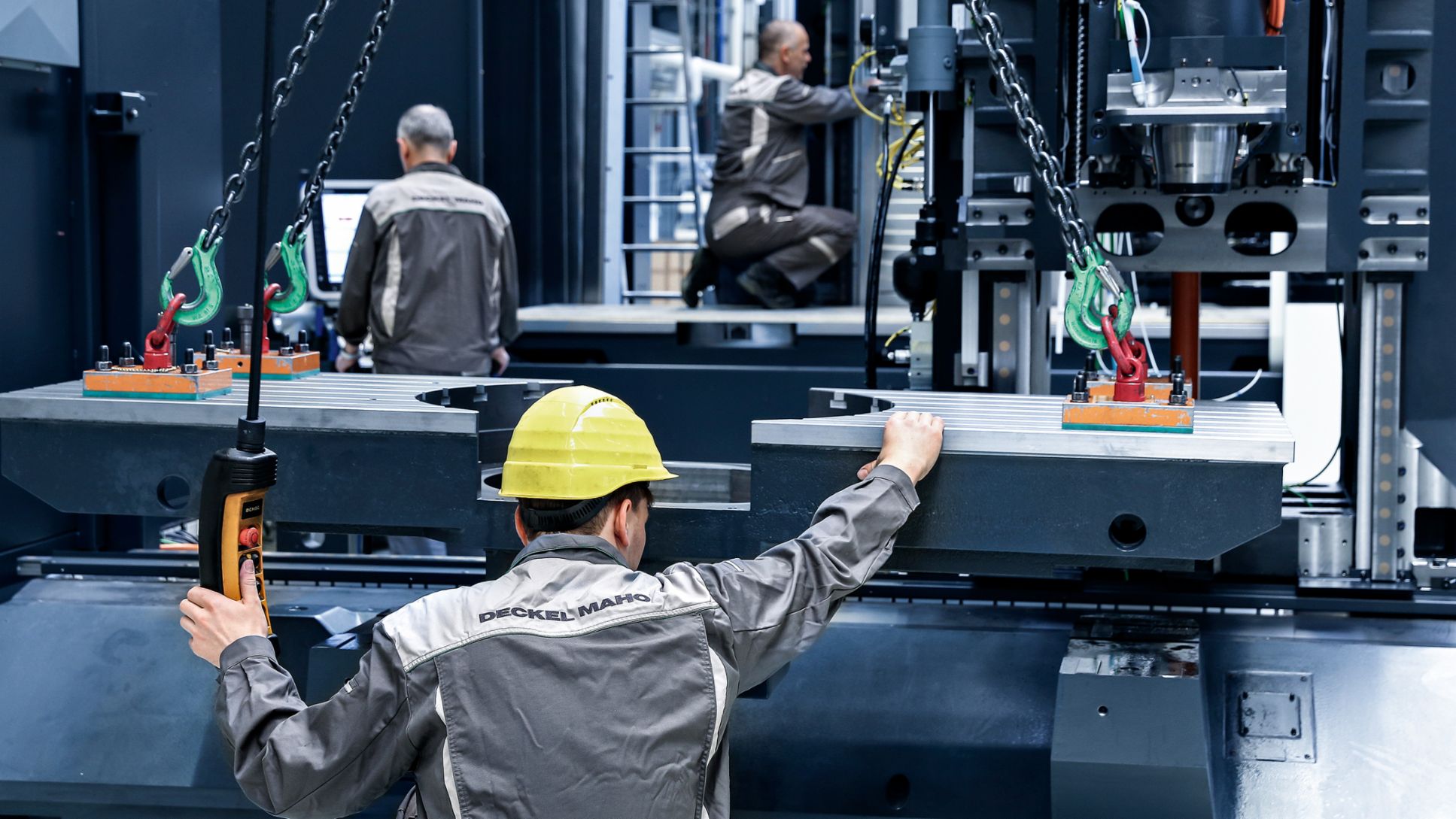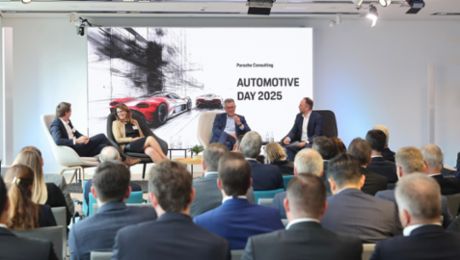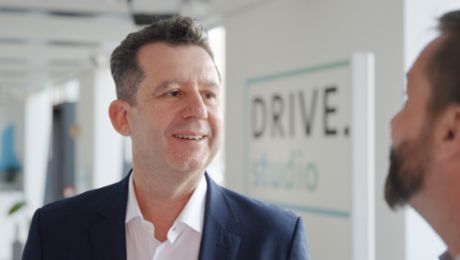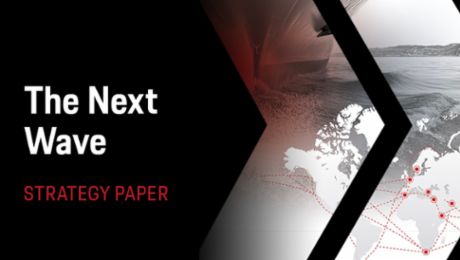What transpires behind the transparent protective door to a high-tech milling machine at DECKEL MAHO is fascinating for experts and laypeople alike. In no time at all a simple block of metal is turned into a complex pump housing or an airplane component that meets the highest demands for functionality and precision. Over the past few decades, the DMG MORI SEIKI Group—a leading international machine tool maker—has developed from a pioneer in this sophisticated field of metal processing to a technological leader in five-axis machinery.
The largest site in the DMG MORI SEIKI AKTIENGESELLSCHAFT (formerly GILDEMEISTER Aktiengesellschaft) is DECKEL MAHO Pfronten. With 25 years of experience, this company located in the eastern Allgäu region of southern Germany serves as the group’s center of excellence for five-axis simultaneous machining systems. Components of up to six meters in length and with a maximum weight of 40 tons can be machined at the processing centers located here—and production capacity extends up to 1,500 machines a year.
Breaking the vicious circle
A major factor in the site’s success consists of fulfilling individual customer wishes, from technological developments to complete assembly lines. The five-axis milling machines are always made to fill customer orders, including customized options and complete turnkeys. The breakthrough “First Quality” quality management system lays a firm foundation for continuous optimization of quality throughout the development process—from product design to use of machinery.
Innovation-fueled growth at Pfronten plus the expansion of its modular system had pushed the site’s production system to the limits of its capacity. In addition, component supply problems were posing ever more frequent threats to production deadlines. If such issues are addressed by ad hoc actions and if the associated modifications to schedules tie up even more available capacity, a vicious circle arises—one that is all too familiar to machinery makers.
Here it must be said that the plant in Pfronten was already well organized. But its managers wanted it to be even better—and they were ready to abandon traditional principles if that would facilitate improvement. So in 2010 Christian Thönes, then Managing Director of Deckel Maho Pfronten, brought ten top managers from his company together with experts from Porsche Consulting to the Porsche site in Stuttgart-Zuffenhausen. They held a workshop to analyze and discuss the status quo. As Thönes recalls, “We were especially concerned with achieving a continuous process chain and streamlining the supply chain to improve planning and delivery reliability—across the entire process from customer to customer—which means from sales, planning, procurement, and logistics to production and delivery.”
Bead string and fish ladder
The consultants took a holistic approach in their proposals. Together with DECKEL MAHO, they developed a fundamentally different philosophy for the order throughput system, with all the steps intelligently linked as part of an overall plan and transferred to a timeline in the form of a horizontal (time frame) model.
That included two principles with metaphorical names. First, the “string of beads”: a set sequence of machine production with defined restrictions to smooth out the needs of the re-spective assembly lines. Second, the “fish ladder” to ensure feasibility: clearance for each step of the order processing system is only given if the desired quality is achieved. As such, these steps build on each other—throughout the entire process. They are all precisely defined and mutually coordinated temporally in accordance with the horizontal model. They follow a certain takt—or to put it figuratively, a certain heart rate—which is ultimately determined by the customer orders. This heart rate is controlled by the brain behind the entire process: the planning.
This might sound like a straitjacket that robs the workforce of all flexibility. That impression would be both right and wrong. As Thönes explains, “To reach an increase in productivity we needed stable processes and optimal coordination at the interfaces to other departments.” The horizontal model does in fact compel the machinery producer to make more stable plans in order to ensure a constant flow of components from suppliers as well as constant use of its machinery and capacities. But realistic guidelines enable greater efficiency and contain built-in leeway for flexibility. By the same token, controlled processes lead the way to improved quality assurance.”
In putting these principles into practice, the consultants could base their work on the highly efficient processes at the Porsche plants in Stuttgart-Zuffenhausen and Leipzig—with one essential difference. Gregor Grandl, a Porsche Consulting partner responsible for mechanical and plant engineering, explains that “car makers design a vehicle in all its variants and then start producing it. Design and production thus run sequentially. In the mechanical engineering sector, however, these processes are interwoven, and every finished piece of machinery features specific engineering and components that have to be individually procured or produced. That makes optimization more complex than in the automotive sector, in part because you have to check and ensure the feasibility of every single machine.”
Planning the horizon
Following a thorough review of the starting situation, which did in fact show a need for action in areas such as setting the takt throughout the order processing system as well as in the purchasing and logistics processes, the optimization process was launched right in production. According to Alfred Geißler, the chief technical officer at DECKEL MAHO Pfronten, “Porsche Consulting’s coherent concept for the entire order processing system made immediate sense to us, and it still serves as a role model. It assumes that production is the basis for stabilizing processes.”
The first steps that DECKEL MAHO took in Pfronten, therefore, were to establish systematic planning and control in accordance with the horizontal model and to introduce efficient shopfloor management to secure it. The company also restructured its assembly system. As Geißler explains, “We use line assembly for high-volume production series, and we have improved the takt for material supply here. We now use cluster assembly for lower-volume machinery orders. This consists of takt-based work stations at which an autonomous group of about ten employees is responsible for four assembly stations.”
The managers in Pfronten achieved the aim of their measures—a well-planned order throughput system with an even takt. “We have considerably increased productivity, raised delivery reliability to around 95 percent, and shortened throughput time by 10 percent,” reports Commercial Director Steffen Burghoff. “And stablizing the entire throughput has made a world of difference. This has enabled us to reduce inventory levels by tens of millions of euros. As a result, we are now able to feed material to the assembly line in small volumes, at high frequencies—and right on takt. The material is then picked onto feeder lines and supplied by tugger trains using a milk-run system. And this in turn reduces fork-lift traffic to an absolute minimum.”
Operational excellence by TAKT
Christian Thönes, who, as a member of the plant’s management board, launched and led the improvement process, was transferred in January 2012 from Pfronten to the executive board of the parent company DMG MORI SEIKI AKTIENGESELLSCHAFT, where he is now in charge of product development, production, and technology. In this position he continues to promote the optimization processes, now on a trans-site basis. “We want to learn from the best and to improve on a continuous basis,” he says. He was impressed by the initial approach of the horizontal model taken in the short-term Pfronten project with Porsche Consulting. That is why optimization projects are now being rolled out on DMG’s own initiative at other production sites.
As Thönes continues, “Our group-wide TAKT initiative is enabling us to create a clear framework for continuous improvement of company processes that can be used at every site. This planning system will now be rolled out at other plants as well.” TAKT’s primary goals are smoother processes in every department, which leads to noticeable improvement in quality, better delivery reliability, a reduction in complexity, and lower inventory.
Care has always been taken to involve the employees at the respective sites. As Burghoff notes, “Our shopfloor colleagues, in particular, were skeptical at first. They were used to preparing assembly steps very independently. They would deal with things like component shortages, for example, or commission material from non-central warehouses. Now our employees can utilize their broad range of qualifications to focus much more on assembly content and progress. Search and transport times have been reduced, and the higher level of productivity is laying the foundation for handling the company’s growth.” Burghoff is impressed by the restructured order-processing system. “The processes are now much more effective and have fewer disturbances.”
Info
Text first published in „Porsche Consulting - THE MAGAZINE", Issue 15
Author: Gerals Scheffels




